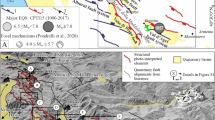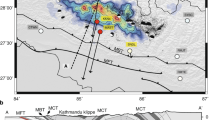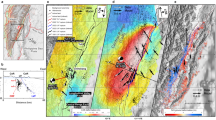Abstract
Observations in tectonically active areas increasingly reveal sets of high-angle conjugate faults (‘cross-faults’) that apparently contradict theories of faulting based on experimental data. Possible explanations include a low in situ coefficient of friction, dominant control of ductile shear zones in the lower crust, and tectonic rotation. Discrimination between these mechanisms has been hindered by uncertainties in the state of stress, deformation history and fault geometry at seismogenic depths. Here we use a combination of seismic, geodetic and geologic data to demonstrate that ubiquitous cross-faults in the Ridgecrest (California) area, including those ruptured in the sequence of strong earthquakes in 2019, result from rotation from an initially optimal orientation consistent with experimental data. The inferred rotation pattern can be explained by the geodetically measured velocity field. Our model suggests that the observed asymmetric rotation of faults in the Eastern California Shear Zone can result from simple shear. The same mechanism can be responsible for high-angle conjugate faults observed in other tectonic settings.
This is a preview of subscription content, access via your institution
Access options
Access Nature and 54 other Nature Portfolio journals
Get Nature+, our best-value online-access subscription
$29.99 / 30 days
cancel any time
Subscribe to this journal
Receive 12 print issues and online access
$259.00 per year
only $21.58 per issue
Buy this article
- Purchase on Springer Link
- Instant access to full article PDF
Prices may be subject to local taxes which are calculated during checkout




Similar content being viewed by others
Data availability
All data used in this study are open access. The first motion focal mechanism of the 2019 Mw 7.1 mainshock is available at https://earthquake.usgs.gov/earthquakes/eventpage/ci38457511/focal-mechanism. The seismic moment of the 2019 Mw 7.1 mainshock is available at https://earthquake.usgs.gov/earthquakes/eventpage/ci38457511/moment-tensor. The seismic moment of the 2019 Mw 6.4 foreshock is available at https://earthquake.usgs.gov/earthquakes/eventpage/ci38443183/moment-tensor. The waveform-relocated earthquake catalog for southern California from ref. 47 is available at https://scedc.caltech.edu/research-tools/alt-2011-dd-hauksson-yang-shearer.html. The GNSS position time series from the PBO is available at https://doi.org/10.7283/P2HT0Z. The coseismic displacement data and fault slip models from ref. 28 are available at https://doi.org/10.5281/zenodo.4646321.
Code availability
MATLAB codes used to generate results presented in this study are available at https://doi.org/10.5281/zenodo.4646292
References
Anderson, E. M. The Dynamics of Faulting and Dike Formation with Application to Britain (Oliver and Boyd, 1951).
Scholz, C. H. The Mechanics of Earthquakes and Faulting 3rd edn (Cambridge Univ. Press, 2019).
Byerlee, J. Friction of rock. Pure Appl. Geophys. 116, 615–626 (1978).
Sibson, R. H. Rupture nucleation on unfavorably oriented faults. Bull. Seism. Soc. Am. 80, 1580–1604 (1990).
Lockner, D. A., Byerlee, J., Kuksenko, V., Ponomarev, A. & Sidorin, A. in Fault Mechanics and Transport Properties of Rocks (eds Evans, B. & Wong, T.) 3–31 (Academic, 1992).
Walsh, J. & Watterson, J. Dips of normal faults in British Coal Measures and other sedimentary sequences. J. Geol. Soc. 145, 859–873 (1988).
Collettini, C. & Sibson, R. H. Normal faults, normal friction? Geology 29, 927–930 (2001).
Mount, V. & Suppe, J. State of stress near the San Andreas fault: implications for wrench tectonics. Geology 15, 1143–1146 (1987).
Zoback, M. D. et al. New evidence on the state of stress of the San Andreas fault system. Science 238, 1105–1111 (1987).
Wernicke, B. Low-angle normal faults and seismicity: a review. J. Geophys. Res. 100, 20159–20174 (1995).
Wang, K. & Fialko, Y. Observations and modeling of coseismic and postseismic deformation due to the 2015 Mw 7.8 Gorkha (Nepal) earthquake. J. Geophys. Res. 123, 761–779 (2018).
Ron, H., Beroza, G. & Nur, A. Simple model explains complex faulting. Eos 82, 125–129 (2001).
Sibson, R. Reverse fault rupturing: competition between non-optimal and optimal fault orientations. Geol. Soc. Spec. Publ. 367, 39–50 (2012).
Wintsch, R., Christoffersen, R. & Kronenberg, A. Fluid-rock reaction weakening of fault zones. J. Geophys. Res. 100, 13021–13032 (1995).
Faulkner, D. R., Mitchell, T. M., Healy, D. & Heap, M. J. Slip on ‘weak’ faults by the rotation of regional stress in the fracture damage zone. Nature 444, 922–925 (2007).
Noda, H., Dunham, E. & Rice, J. R. Earthquake ruptures with thermal weakening and the operation of major faults at low overall stress levels. J. Geophys. Res. 114, B07302 (2009).
Di Toro, G. et al. Fault lubrication during earthquakes. Nature 471, 494–498 (2011).
Han, R., Hirose, T. & Shimamoto, T. Strong velocity weakening and powder lubrication of simulated carbonate faults at seismic slip rates. J. Geophys. Res. 115, B03412 (2010).
Brown, K. M. & Fialko, Y. ‘Melt welt’ mechanism of extreme weakening of gabbro at seismic slip rates. Nature 488, 638–641 (2012).
Fialko, Y. in Treatise on Geophysics 2nd edn, Vol. 4 (ed. Schubert, G.) 73–91 (Elsevier, 2015).
Chester, J. S., Chester, F. M. & Kronenberg, A. K. Fracture surface energy of the Punchbowl fault, San Andreas system. Nature 437, 133–136 (2005).
Copley, A. The strength of earthquake-generating faults. J. Geol. Soc. 175, 1–12 (2018).
Mitchell, E., Fialko, Y. & Brown, K. M. Velocity-weakening behavior of Westerly granite at temperature up to 600°C. J. Geophys. Res. 121, 6932–6946 (2016).
Angelier, J. Tectonic analysis of fault slip data sets. J. Geophys. Res. 89, 5835–5848 (1984).
Nicholson, C., Seeber, L., Williams, P. & Sykes, L. R. Seismic evidence for conjugate slip and block rotation within the San Andreas fault system, southern California. Tectonics 5, 629–648 (1986).
Ross, Z. E. et al. Hierarchical interlocked orthogonal faulting in the 2019 Ridgecrest earthquake sequence. Science 366, 346–351 (2019).
Chen, K. et al. Cascading and pulse-like ruptures during the 2019 Ridgecrest earthquakes in the Eastern California Shear Zone. Nat. Commun. 11, 22 (2020).
Jin, Z. & Fialko, Y. Finite slip models of the 2019 Ridgecrest earthquake sequence constrained by space geodetic data and aftershock locations. Bull. Seismol. Soc. Am. 110, 1660–1679 (2020).
Magen, Y., Ziv, A., Inbal, A., Baer, G. & Hollingsworth, J. Fault rerupture during the July 2019 Ridgecrest earthquake pair from joint slip inversion of InSAR, optical Imagery, and GPS. Bull. Seismol. Soc. Am. 110, 1627–1643 (2020).
Ponti, D. et al. Documentation of surface fault rupture and ground-deformation features produced by the 4 and 5 July 2019 Mw 6.4 and Mw 7.1 Ridgecrest earthquake sequence. Seismol. Res. Lett. 91, 2942–2959 (2020).
Yang, W. & Hauksson, E. The tectonic crustal stress field and style of faulting along the Pacific North America Plate boundary in Southern California. Geophys. J. Int. 194, 100–117 (2013).
Templeton, E. L. & Rice, J. R. Off-fault plasticity and earthquake rupture dynamics: 1. Dry materials or neglect of fluid pressure changes. J. Geophys. Res. 113, B09306 (2008).
Takeuchi, C. & Fialko, Y. Dynamic models of interseismic deformation and stress transfer from plate motion to continental transform faults. J. Geophys. Res. 117, B05403 (2012).
Montesi, L. Fabric development as the key for forming ductile shear zones and enabling plate tectonics. J. Struct. Geol. 50, 254–266 (2013).
Takeuchi, C. & Fialko, Y. On the effects of thermally weakened ductile shear zones on postseismic deformation. J. Geophys. Res. 118, 6295–6310 (2013).
Fialko, Y. & Simons, M. Deformation and seismicity in the Coso geothermal area, Inyo County, California: observations and modeling using satellite radar interferometry. J. Geophys. Res. 105, 21781–21793 (2000).
Nur, A., Ron, H. & Scotti, O. Fault mechanics and the kinematics of block rotations. Geology 14, 746–749 (1986).
Thatcher, W. & Hill, D. P. Fault orientations in extensional and conjugate strike-slip environments and their implications. Geology 19, 1116–1120 (1991).
Dokka, R. K. & Travis, C. J. Role of the Eastern California shear zone in accommodating Pacific-North American plate motion. Geophys. Res. Lett. 17, 1323–1327 (1990).
Chen, J. H. & Moore, J. G. Late Jurassic Independence dike swarm in eastern California. Geology 7, 129–133 (1979).
Savage, J., Gan, W. & Svarc, J. Strain accumulation and rotation in the Eastern California Shear Zone. J. Geophys. Res. 106, 21995–22007 (2001).
Fialko, Y. A. & Rubin, A. M. Thermal and mechanical aspects of magma emplacement in giant dike swarms. J. Geophys. Res. 104, 23033–23049 (1999).
Hudnut, K. W., Seeber, L. & Pacheco, J. Cross-fault triggering in the November 1987 Superstition Hills earthquake sequence, southern California. Geophys. Res. Lett. 16, 199–202 (1989).
Jennings, C. & Bryant, W. Fault Activity Map of California Geologic Data Map No. 6 (California Division of Mines and Geology, 2010).
Fialko, Y. Probing the mechanical properties of seismically active crust with space geodesy: study of the coseismic deformation due to the 1992 Mw7.3 Landers (southern California) earthquake. J. Geophys. Res. 109, B03307 (2004).
Hauksson, E., Yang, W. & Shearer, P. M. Waveform relocated earthquake catalog for southern California (1981 to June 2011). Bull. Seismol. Soc. Am. 102, 2239–2244 (2012).
Fialko, Y., Simons, M. & Agnew, D. The complete (3-D) surface displacement field in the epicentral area of the 1999 Mw7.1 Hector Mine earthquake, southern California, from space geodetic observations. Geophys. Res. Lett. 28, 3063–3066 (2001).
Fialko, Y., Sandwell, D., Simons, M. & Rosen, P. Three-dimensional deformation caused by the Bam, Iran, earthquake and the origin of shallow slip deficit. Nature 435, 295–299 (2005).
Tymofyeyeva, E. & Fialko, Y. Mitigation of atmospheric phase delays in InSAR data, with application to the eastern California shear zone. J. Geophys. Res. 120, 5952–5963 (2015).
Wessel, P., Smith, W. H. F., Scharroo, R., Luis, J. & Wobbe, F. Generic Mapping Tools: improved version released. Eos 94, 409–410 (2013).
Acknowledgements
We thank O. Zielke and M.-H. Huang for their comments. This study was supported by NSF (grants EAR-1841273 and EAR-1945760) and NASA (grant 80NSSC18K0466). Figures were produced using Generic Mapping Tools50 and MATLAB.
Author information
Authors and Affiliations
Contributions
Y.F. performed the data analysis and wrote the manuscript. Z.J. provided a finite fault model of the 2019 Ridgecrest earthquakes and contributed to the graphics design.
Corresponding author
Ethics declarations
Competing interests
The authors declare no competing interests.
Additional information
Peer review information Nature Geoscience thanks Olaf Zielke and Mong-Han Huang for their contribution to the peer review of this work. Primary Handling Editor: Stefan Lachowycz.
Publisher’s note Springer Nature remains neutral with regard to jurisdictional claims in published maps and institutional affiliations.
Supplementary information
Supplementary Information
Supplementary methods, Figs. 1–9 and references.
Rights and permissions
About this article
Cite this article
Fialko, Y., Jin, Z. Simple shear origin of the cross-faults ruptured in the 2019 Ridgecrest earthquake sequence. Nat. Geosci. 14, 513–518 (2021). https://doi.org/10.1038/s41561-021-00758-5
Received:
Accepted:
Published:
Issue Date:
DOI: https://doi.org/10.1038/s41561-021-00758-5
This article is cited by
-
Three-dimensional kinematics of the India–Eurasia collision
Communications Earth & Environment (2023)
-
2019 M7.1 Ridgecrest earthquake slip distribution controlled by fault geometry inherited from Independence dike swarm
Nature Communications (2023)
-
Major southern San Andreas earthquakes modulated by lake-filling events
Nature (2023)
-
Fine detection of large-scale complex geological structures based on geophysical prospecting techniques
Environmental Earth Sciences (2023)
-
Accrual of widespread rock damage from the 2019 Ridgecrest earthquakes
Nature Geoscience (2022)



